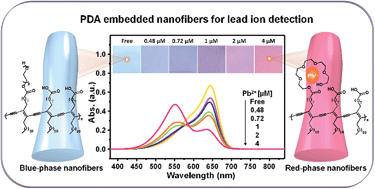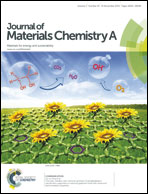Colorimetric strips for visual lead ion recognition utilizing polydiacetylene embedded nanofibers†
Abstract
Given the dire consequences of accidental lead ion (Pb2+) exposure, a portable, sensitive and robust analytical approach capable of colorimetric visualization is highly desirable. In this study, we demonstrate a colorimetric strip that relies on a novel polydiacetylene (PDA) embedded polyacrylonitrile nanofibrous membrane (PAN NFM). The Pb2+-chromic PDA is prepared from controlled mixtures of 10,12-pentacosadiynoic acid (PCDA) and PCDA-5EG, a PCDA derivative with a pentaethylene glycol headgroup. Moreover, the Pb2+ complexation ability is manipulated by controlling the molar ratio of PCDA to PCDA-5EG. The PAN NFM acting as a three dimensional matrix is designed for PDA immobilization, thereby improving the stability, portability and sensitivity. Upon exposure to a series of metal ions, only Pb2+ could induce a color change, which clearly showed that our strip could act as a highly selective probe to detect Pb2+. Ultimately, the strip with a naked eye detection limit of 0.48 μM undergoes a brilliant color transition, from blue to red, in a concentration-dependent manner and all the color transitions of strips are quantitatively visualized by employing a chromatic framework. The findings indicate that the strip is particularly promising for visual Pb2+ recognition due to its facile functionalization, simple construction, and versatility to empower colorimetric signaling.

- This article is part of the themed collection: 2014 Journal of Materials Chemistry A Hot Articles

 Please wait while we load your content...
Please wait while we load your content...